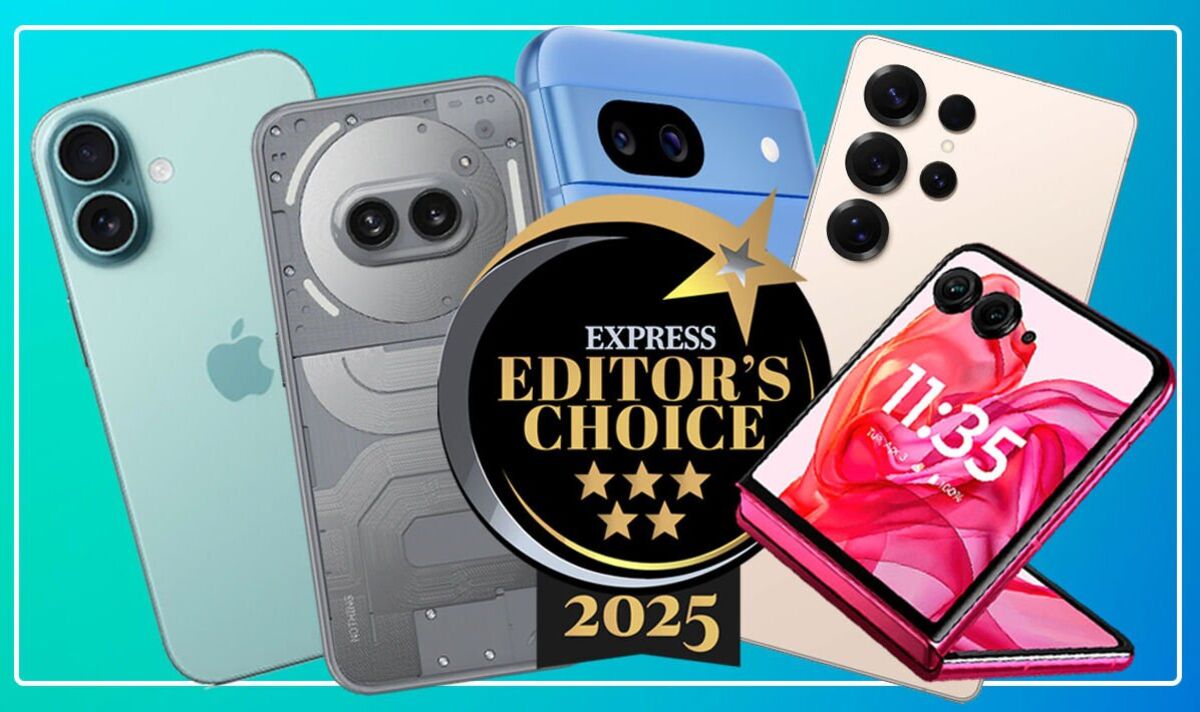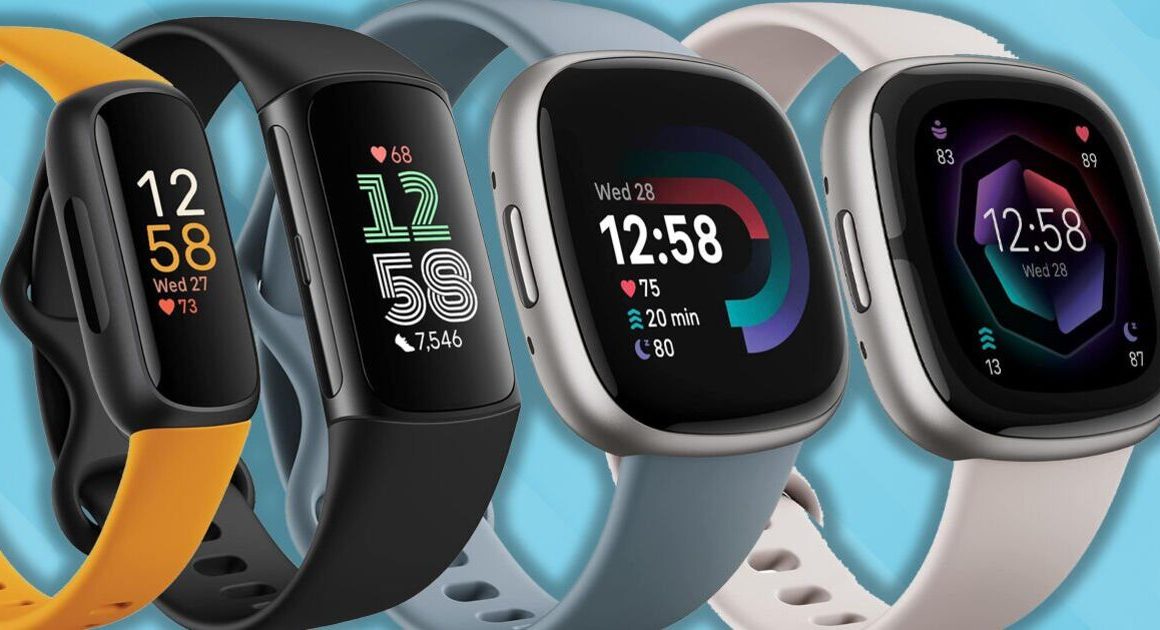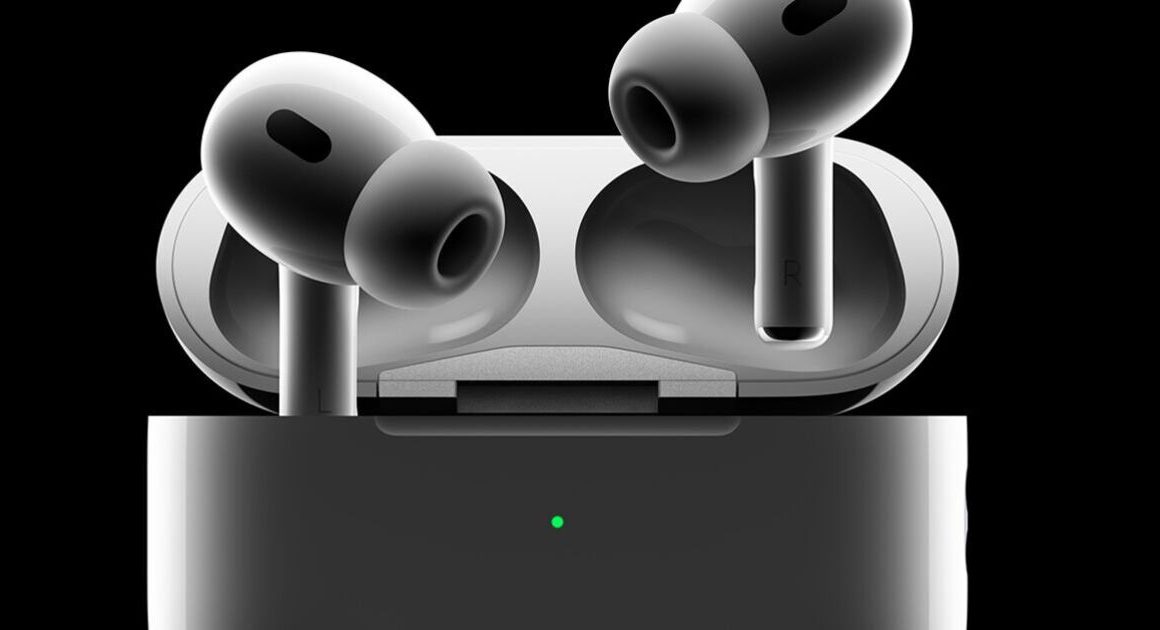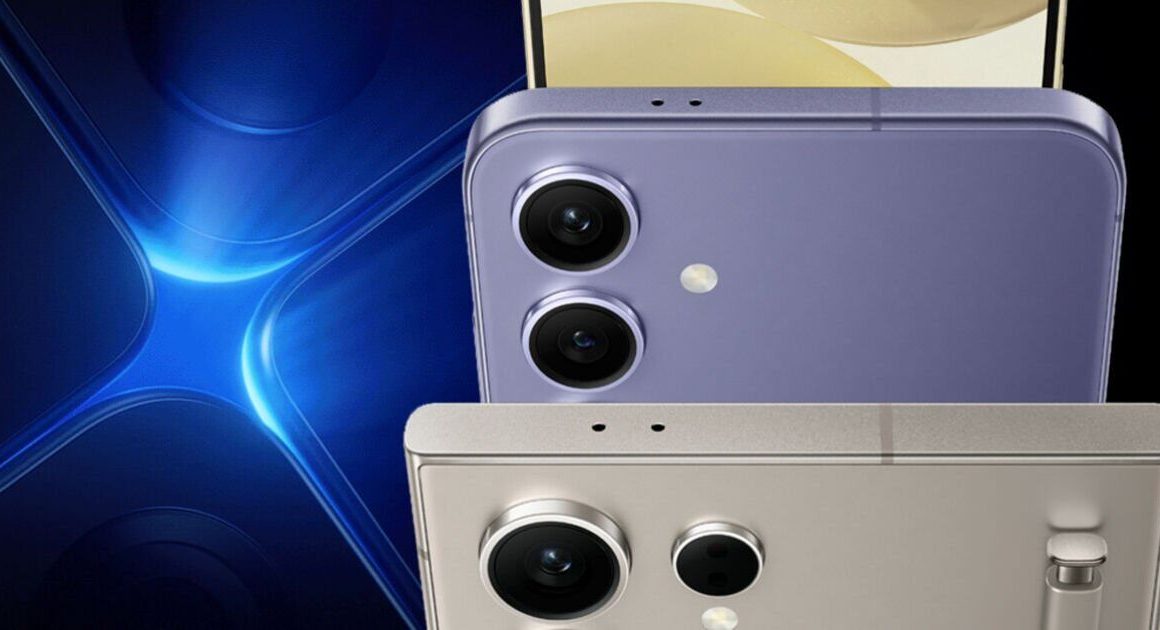
This is our definitive run down of the ten best phones you can buy. (Image: Apple/Nothing/Google/Samsung/Motorola/Express)
There are an overwhelming number of smartphones to choose from in 2025, from the familiar Apple iPhone lineup to the wonderful world of Android, where there are umpteen different phones vying for your attention on shop shelves and on online stores.
Whether you want a big screen and great battery life or a small phone with a great camera, there are plenty of options to mix and match the features you want at the price you’re willing to pay, particularly given we are all upgrading far less often than we used to. A phone should last for several years.
At Express.co.uk, our expert tech editors test all the major smartphones released in the UK and put them through their paces to find out if they are as good as the adverts say they are, or if you’re better off spending your money elsewhere.
In this article, we’ve rounded up the ten best smartphones money can buy, with a nod to those who also would prefer to spend a little less, because ‘best’ doesn’t always equal ‘most expensive’.
Apple and Samsung are here, but you have plenty of other options from OnePlus, to Honor, to Google, or even newcomers such as Nothing and companies you maybe didn’t know still made phones, such as Motorola. There’s a perfect phone out there for everyone.
Here are the best phones you can buy in the UK in 2025, each of which has also been fully reviewed and rated by the tech tea, here at Express.co.uk.
1. Samsung Galaxy S25 Ultra

Samsung Galaxy S25 Ultra (Image: Samsung)
What we love
- Stunning design
- Fast processor
- Great quad cameras
- Ludicrous battery life
- Sublime screen
- Plenty of AI
What we don’t
- It’s expensive
- No Bluetooth S Pen
- Do you really need AI in your life?
Though it’s one of the most expensive out there, the Samsung Galaxy S25 Ultra is the best phone you can buy. That’s thanks to a kitchen-sink approach to building a smartphone with top end Snapdragon 8 Elite chip, great quadruple cameras that are incredibly versatile, a stylus, huge anti-reflective display and two-day battery life with wireless charging and can handle anything you throw at it, from high-end mobile gaming to 8K video recording and on-device editing, capable multitasking thanks to 16GB RAM and polished One UI 7 Android software.
It is an enormous phone, but the industry has decided that a big phone equals most features, and if you want them all, this phone has it. The S Pen stylus lets you write or draw in apps and on screenshots, one of the only phones available with this perk, but the gadget lacks the Bluetooth gestures of older models, which is a shame. If you can get 2024’s Galaxy S24 Ultra on sale, it’s practically the same phone.
We can take or leave most of the Galaxy AI features too, though summarising emails and notes, as well as audio recordings, is clever and handy. But this phone is great without all of the gimmicky AI on show here, and the amazing seven years of software support till 2031 is the icing on the cake.
Read our full Samsung Galaxy S25 Ultra review
2. OnePlus 13

OnePlus 13 (Image: OnePlus)
What we love
- Genuinely incredible battery life
- Very fast performance
- Outstanding main camera
- Thoughtful software tweaks
- Best haptics on a phone
What we don’t
- AI isn’t very useful
- No charger in the box
- Shorter software support than rivals
- Not available on contract in the UK
If you want most of the features found in the Galaxy S25 Ultra but prefer the look of £899 compared to £1,249, the OnePlus 13 is the phone for you. Aside from the lack of stylus, the 13 excels in every area Samsung does, with an outstanding screen, great performance from the same processor, arguably better cameras (though lacks the second zoom lens), a very good display and an often ignored plus, excellent haptics – that is, the vibration motor. It’s very good and makes the phone feel premium.
The battery life is also best in class thanks to a larger 6,000mAh cell that uses more efficient silicon-carbon tech compared to traditional lithium-ion batteries. There’s no charger in the box, but pick up the correct OnePlus one and you can recharge this phone from flat to full in about half an hour, another way the 13 beats its closest rivals.
One downside to the software is it’ll only get four years of Android updates and five of security patches. This lags behind Google and Samsung, both of whom offer seven years all round for many of their smartphones.
Read our full OnePlus 13 review
3. Samsung Galaxy S25

Samsung Galaxy S25 (Image: Samsung)
What we love
- Small for a modern smartphone
- S25 Plus has better display, battery and charging speeds
- Top performance
- Great cameras including telephoto lens
- Excellent software
- Seven years of software support
What we don’t
- There’s not much new compared to older Galaxy S phones
- AI smarts are mostly gimmicky
- Only 128GB on £799 S25
If you’re after one of the best Android phones but don’t want something that sticks out the top of your pocket because it’s so huge, the regular Samsung Galaxy S25 could be the phone for you. We’ve been very impressed by its performance, sporting the same chip as the S25 Ultra, and the inclusion of three different camera lenses including a telephoto zoom, something the iPhone 16 lacks for the same £799 price.
The 6.2-inch screen is compact for a smartphone in 2025 and means you can actually use the thing one-handed. That display is sharp and bright, and the build is premium with glass and metal matte back and sides respectively not showing any fingerprints on the lighter coloured versions, with plenty of hues available if you buy directly from Samsung.
The £999 S25 Plus gets you a larger 6.7-inch screen with a higher resolution, as well as a larger battery with faster 45W charging compared to the 25W speeds on the smaller model.
Read our full Samsung Galaxy S25 and S25 Plus review
4. Apple iPhone 16

Apple iPhone 16 (Image: Apple)
What we love
- Bold new colours
- Action Button is here
- Camera Control is useful addition
- Longer battery life
- Faster charging
- Ludicrous performance
- Tougher design
What we don’t
- No Apple Intelligence at launch
- 60Hz screen is still annoying
- New MagSafe needed for quick refilling
There’s very little reason to get the pricier Pro iPhone this year instead of the standard iPhone 16. Apple really needs to upgrade this phone’s display to 120Hz, as most other phones in this price range (and cheaper) include one. But aside from that, the iPhone 16 delivers with excellent performance, capable cameras, a relatively compact design and fun colour options. Our vote is for the Teal option, but the blue Ultramarine is also lovely.
Surprisingly, this cheaper iPhone gets the Action Button and Camera Control button found on the iPhone 16 Pro, though it lacks a third camera lens for zoom shots. Apple also annoyingly leaves off the ability to shoot in RAW in the camera app, but most people won’t care or need advanced features like that.
With the A18 chip, the phone can also run Apple Intelligence, Apple’s new AI software. It leaves a lot to be desired, like with most AI on modern phones, but you can ignore it. You’re really here for the familiar and reliable iOS 18 software that’s now more customisable and just as smooth as ever. If you have an iPhone and need a new one, this should be your default choice.
Read our full iPhone 16 review
5. Google Pixel 8a
![]()
Google Pixel 8a (Image: Google)
What we love
- Relatively compact size
- Excellent main camera
- Solid battery life
- Seven years of software support
- Good performance
What we don’t
- Very similar to the Pixel 8 in features and price
- Not the greatest screen quality
- Slow charging
Google’s mid-range A series phones aren’t the true value proposition they once were but if you can find the £499 Pixel 8a on sale it’s one of the best mid-range phones going. It’s cheaper than the Pixel 9 thanks to plastic construction, a lower resolution screen and older processor, but for all intents and purposes the camera quality is just as good as pricier Pixels thanks to Google’s great photo processing.
You get seven years of software updates to 2031 and the advantage of getting these monthly upgrades fastest because Google makes Android. The software is clean but customisable and battery life is solid. Its 6.1-inch screen and overall size makes it comparable to the £799 iPhone 16 but costs hundreds less, which is a win in our book.
There’s wireless charging if you want it, plus features such as an always-on display, stereo speakers, iP67 water and dust resistance and all the Google AI tools of other Pixels.
Read our full Google Pixel 8a review
6. Google Pixel 9 Pro
![]()
Google Pixel 9 Pro (Image: Google)
What we love
- Truly outstanding cameras
- Good performance
- All-day battery life
- Compact for a smartphone in 2024
- Excellent biometrics
What we don’t
- Only 128GB for £999
- Pixel 8a has many of the same features for £499
It’s best to think of the Google Pixel 9 Pro as the iPhone for Android. That’s a compliment, not an insult. This is the best phone Google has ever made with an excellent build and design and tastefully minimalist Android software. The triple cameras are better than the iPhone for still images and Google is offering seven years of software support to take you to 2031.
The 9 Pro is stuffed full of Gemini, Google’s AI app and tools, and some of them are useful. Transcription in real time works amazingly well, and you can summarise emails, texts and webpages, as well as erase people from photos and other imaging tools.
If you don’t want the telephoto camera and metal build then you could save £200 and get the Pixel 9, which has the same software and main camera, battery and features. The Pro has a nicer screen and more camera features, but that’s about it. Alternatively you can spend more and get the Pixel 9 Pro XL with a larger screen and battery. All are excellent.
Read our full Google Pixel 9 Pro review
7. Apple iPhone 16 Pro Max

Apple iPhone 16 Pro Max (Image: Apple)
What we love
- Ludicrously fast A18 Pro chip
- Bigger displays
- New Camera Control
- Improved rear cameras
- Longer battery life
- Faster charging
- Tougher than before
What we don’t
- Can get expensive
- Apple Intelligence has limited appeal
- Needs new MagSafe puck for fast charge
If you want the best iPhone ever, the 16 Pro Max is it. Though it is expensive and large, making the iPhone 16 a better choice for most iOS fans, the Max is the ultimate iPhone with superlative cameras with advanced ‘Pro’ features, great battery life, premium titanium build and zippy performance from the A18 Pro chipset inside.
Thanks to very slim bezels this is the largest ever iPhone screen at 6.9-inches, a true pocket buster, skinny jeans wearers beware. At least the display is phenomenally good, with Apple’s excellent ProMotion and True Tone colour tech.
It doesn’t add quite as much as Pro iPhones have done in previous years over the regular iPhone, though you can save some cash by going for the smaller iPhone 16 Pro.
Read our full iPhone 16 Pro Max review
8. Honor Magic V3

Honor Magic V3 (Image: Honor)
What we love
- Incredible, thin design
- Feels like a normal phone when closed
- Top performance
- Good battery life with fast charging
- Great camera
What we don’t
- Comes with tons of bloatware
- Software needs optimising
- Expensive
Foldable phones have been tweaked and refined over the last few years to the point we can now recommend them as direct replacements for regular phones, despite the folding fragility you’re buying into. The best book-style folding phone with a vertical bend available in the UK is the Honor Magic V3, an unbelievably thin device even when folded shut at 9.3mm thick (the S25 Ultra is 8.2mm).
Unlike the Samsung Galaxy Z Fold 6, the Magic V3’s outer screen looks and feels like a regular phone in size, so when closed you can just use the V3 as normal with no compromises. Samsung’s phone also lacks the very best possible cameras, whereas the V3’s main lens in particular is just as good as anything you’ll find on a ‘normal’ phone, as long as you don’t mind the relatively large camera bump on the back.
Performance is excellent thanks to the Snapdragon 8 Gen 3 and Honor’s software is better than it has ever been with useful tools like Magic Portal where you can tap and drag photos and text from the app you’re into to any other via a sidebar. The phone is very pricey at £1,699 but Honor often puts it on sale. As of February 2025, it was on offer for £1,299.
Read our full Honor Magic V3 review
9. Nothing Phone 2a Plus

Nothing Phone 2a (Image: Nothing)
What we love
- Delightful software
- Very well priced
- Lightweight build
What we don’t
- Cameras are just OK
- Haptics feel cheap
- Only three years of software updates
Nothing is a UK tech start up and this is its third, and cheapest, phone to date. It’s also the best one – for just £319 it is excellent value with eye-catching design, functional lights on the back, a good screen, solid battery life, and thoughtful Android software. The 2a Plus is also available for £399, but this 2a is a better deal with the same design and most of the specs you need for £80 less.
The camera is nothing to write home about, but it’s solid for the price. The Phone 2a is best as a minimalist’s phone, one to buy, set up, and use as a tool. That’s how we felt best using it, and it could help you use your phone less. This is in part down to Nothing’s software that you can set to look monochrome so those colourful apps don’t draw you in.
It’s also rare to see an always-on display at this price, but you can set your screen time, weather, and other useful information widgets to appear there, reducing the need to pick up your phone. It has a low powered processor, but this also means battery life is great. Along with the Pixel 8a, this is the mid-range phone to go for in 2024.
Read our full Nothing Phone 2a review
10. Motorola Razr 50 Ultra

Motorola Razr 50 Ultra (Image: Motorola)
What we love
- Slim flip design
- Expansive cover screen with full app support
- All day battery
- Fully waterproof
What we don’t
- Cameras aren’t top tier
- Battery life is merely fine
- Motorola isn’t great at updating software
We are very excited for the future of flip-style foldables, not least for the big hit of nostalgia they conjure. Motorola has leant fully into this by resurrecting the Razr branding, recalling its mid-noughties classic flip phone, but the 50 Ultra does more than enough to be a great phone in its own right. The internal screen is big and bright with a less pronounced crease than Samsung’s Galaxy Z Flip 6, but the star of the show is the outer screen that’s large enough to run whole apps on.
This means you can change track on Spotify, use Google Maps, or even text without actually opening the Razr 50 Ultra. This added functionality dovetails nicely with the compact size, making this phone perfect for smaller pockets. Available in a few fun colours, some with fake leather backs to hide fingerprints, this is one way to get a phone none of your friends have.
Motorola’s Android software is also exemplary, with useful tweaks and additions to make it easier to use while largely keeping out of your way. One concern aside from durability is software support, which the firm has a dodgy track record with. But if your phone simply must flip, this is the one to get.
Read our Motorola Razr 50 Ultra review












